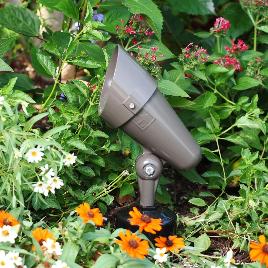Low voltage lighting is the safest and easiest way for do-it-yourselfers to install quality landscape lighting. Unfortunately, the home improvement stores have given some 12-volt lighting systems a bad reputation. Our low voltage lights are composed of the finest quality materials and are designed to be lifetime There are four aspects to the low voltage landscape lighting system that just be selected.
The fixtures and lamps are selected after determining which features of the landscape are to be utilized. To assist in determining the best choice of lamps, please refer to the lamps page. After selection of the lamp, select the fixture according to desired style and finish from our on-line catalog.

The mounting method is determined by the location of the fixture. Use surface mount canopies to allow mounting of fixtures onto decks. Non-metallic stakes are used for ground mounting fixtures and tree mount brackets are used to mount fixtures safely to a tree. These are just a few of the options available to you.
The power console is selected by first determining the total wattage being used in your plan. If more than one power console is required, determine the total wattage to be allocated for each of the areas to be lit. The power console is selected by first determining the total wattage being used in your plan. We suggest that initially you use only 70-80% of the power console’s capacity since most clients will add more fixtures to their system at a later date. Remember, you only pay for the power being used. The mounting location of the power console must also be considered.
The cable length needed will help to determine which gauge cable is best for your job. When laying out a project, always follow our Low Voltage Layout Tips. The layout itself can be accomplished by sketching a view of the property, including all landscape features to be illuminated. Mark the location of each fixture and power console, and then draw dotted lines from the power console to each fixture to indicate your runs of cable (again, always follow our layout tips). Keep a copy of the plan as a reference noting fixture names and wattage lamps. This will come in handy when it is time to re-lamp the fixtures or if you need to replace a broken lens or gasket.
We stock only the best manufacturers of outdoor lighting.Here is a list of just some of the manufacturers we distribute and stock:








© 2024 Landscape Lighting Supply Company. All Rights Reserved.